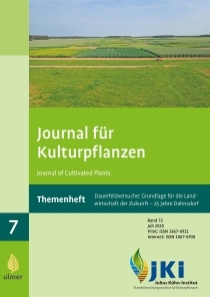Findings and perspectives of a 23-year long-term field trial on integrated plant protection against fungal pathogens in winter wheat
DOI:
https://doi.org/10.5073/JfK.2020.07.04Keywords:
Integrated plant protection, fungal diseases, fungicides, cultivar resistance, long-term field trials, winter wheatAbstract
In order to develop concepts for integrated plant protection, a field trial of the Julius Kühn-Institute was set up in Dahnsdorf (Brandenburg) in 1995 and various long-term field trials were carried out. Within the framework of the largest and oldest on-site long-term field trial “Comparison of Strategies for Environmentally Friendly Plant Protection”, this paper examines the effects of a 50% reduction strategy in phase 1 (1997 to 2007) and a consistent implementation of integrated plant protection (IPS) in phase 2 (2008 to 2013) and modified in phase 3 (2014 to 2019) compared to a practical strategy (GfP), with regard to situation-specific plant protection against fungal pathogens in winter wheat. While in the first two phases of the trial (1997 to 2013) identical varieties were grown in the strategies, in phase 3 an extension was made to include the variety component. The most frequently occurring diseases were leaf blotch (Zymoseptoria tritici, Septoria nodorum), leaf rust (Puccinia triticina) and yellow rust (Puccinia striiformis f. sp. tritici), which occurred with very different intensity over the years depending on weather and disease pressure. The fungicide treatment frequency index, as a measure of the intensity of plant protection, showed a value of 0.8 (situation-related plant protection product application (100%) and 0.4 (50% of situation-related application) in phase 1 on average over the years. This was a significant difference between the strategies to be tested, which was due to the strict reduction of plant protection product applications by 50%. The change of the trial in phase 2 and 3 resulted in a fungicide treatment frequency index of 1.2 and 1.1 in the IPS strategy and 1.7 and 1.9 in the GfP strategy, which proved to be not significantly different. When comparing the yields, there was a significant difference between the strategies in only two (2001, 2006) of the 23 years. Also in comparison with the untreated controls, a significant difference was evident in only four years in the GfP strategy, and in only one year in the IPS strategy. Fungicide applications would often not have been necessary retrospectively. In line with the yields and fungicide treatment frequency indices, the net profit averaged over the six years of phase 3 was also not significantly different. Thus, the differentiation of the GfP and IPS strategies was not sufficient to show a clear difference between them so far, which is ultimately due to the already low fungicide treatment frequency indices in the GfP strategy, which were below those of regional practice in all phases, and to the effective resistances of the selected varieties. Despite the frequent exceeding of the control thresholds and the resulting fungicide applications, the disease progress was often moderate to low. Clear yield differences are only evident in years with high disease pressure and favourable weather conditions for infection.
Downloads
Published
Issue
Section
License
The content of the journal is licensed under the Creative Commons Attribution 4.0 License. Any user is free to share and adapt (remix, transform, build upon) the content as long as the original publication is attributed (authors, title, year, journal, issue, pages).
The copyright of the published work remains with the authors. The authors grant the Journal of Cultivated Plants, the Julius Kühn-Institut and the OpenAgrar repository the non-exclusive right to distribute and exploit the work.







